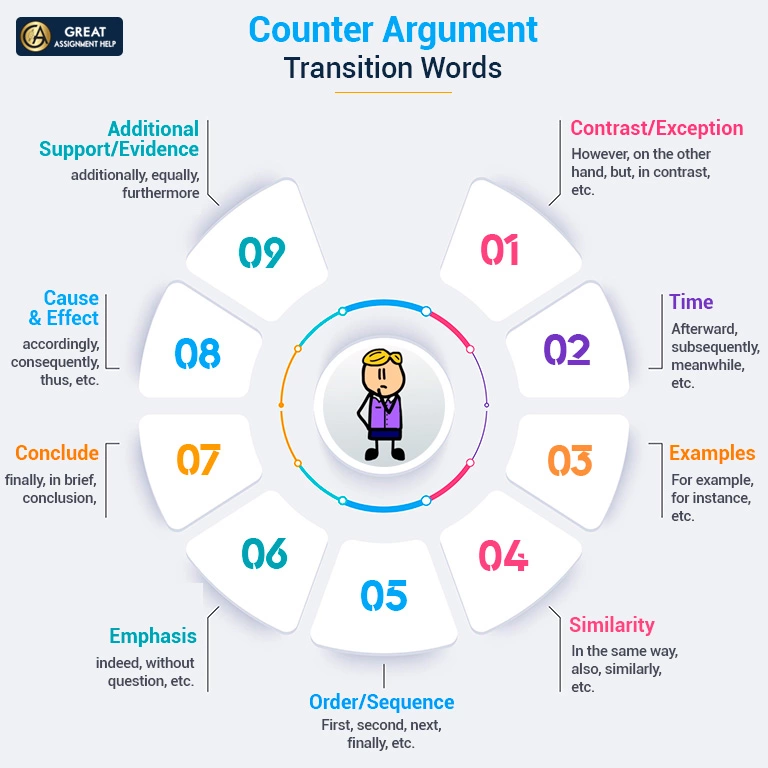Basically, not everyone will have the same opinion about an essay or research topic. Therefore, while writing an academic paper, you can refute your opponent’s argument or opinion, by raising a strong counterargument with supporting facts. But you can’t just present your counterargument; it has some ethical rules as well. Are you wondering how to write a counterargument paragraph? If yes, then check this blog post. Especially, to help you raise a powerful refutation, here, in this blog post, we have shared everything about counter-arguments. Read and follow the counterargument writing steps and tips as presented here.
What is a Counterargument?
A counterargument is an argument presented to oppose an idea opinion or viewpoint. It is one of the best ways to implement persuasive writing and speaking strategies. But mostly, writers use counterarguments to refute and prove their own viewpoints. In simple terms, counterarguments are nothing but contrasting points.
Here is an example of an argument and a counterargument.
Argument: The dog is the best domestic animal for the cow because of its friendly nature.
Counter Argument: The cow is the best domestic animal than the dog because it gives us many dairy products.
Importance of Counter Argument
Why is the counterargument important? Only a counterargument strengthens an argument. To prove that your opinion is accurate against your opponent’s viewpoint, a strong denial statement is needed.
When you include the counterpoints in your persuasive essay, a high chance is there for your essay to get credibility. Using counterarguments in an argumentative essay is one of the smart ways of showing your readers that you are capable of understanding the multiple sides of an argument.
Learn How to Begin a Counterargument
If you want to present a different point of view on a thesis, you should make it clear to your readers either implicitly or explicitly at the very beginning that your paper is contradictory. Your paper will appear blunt and non-contradictory if you don’t give any clues about your denial.
So, how can you inform your readers that your paper opposes a particular idea? Keep in mind to include introductions whenever you begin a counterargument. You can begin with a phrase, a word, or a sentence that makes a general point. Then, in addition to that, you can also use words like “But,” “Similarly,” and “Accordingly,” to support your viewpoint. Remember, depending on your usage, the counterargument may contain complex sentences at times.
Different Ways of Introducing a Counterargument
The counterargument can be written in many different ways. But as said earlier, your reader should be given a signal or any intimation in the beginning that you are refuting an idea. To let your readers know, you can introduce your refutation statement in the form of questions or phrases. Also, you can use any statement to express a writer’s views opposing your views.
Here are some examples of introducing a counterargument.
- But isn’t it true that [State the counter argument]?
- [Isn’t/Wouldn’t/Don’t/] [State the counter argument]?
- Several people [argue/suppose/think/etc.] that [Write your opinions]
- One could easily [think/imagine/suppose/etc.] that [Express your argument]
- It is often [imagined/supposed/etc.] that [State your views]
- It might [appear/look/etc.] as if [State the counter argument]
- However, Mila has written [Write the contradiction statement]
- Stone takes the position that [Mention the statement]
- On the other hand, Mathews argues that [Express the denial statement]
- Socrates thinks that [Mention the counterargument]
Counter Argument Transition Words
Apart from using questions or phrases, you can also use transition words to introduce a refutation statement.
Here are some Counter Argument Transition words that can be used as a replacement for the words that show
- Contrast/Exception: However, on the other hand, but, in contrast, etc.
- Time: Afterward, subsequently, meanwhile, etc.
- Examples: For example, for instance, etc.
- Similarity: In the same way, also, similarly, etc.
- Order/Sequence: First, second, next, finally, etc.
- Emphasis: indeed, without question, etc.
- Conclude: finally, in brief, conclusion,
- Cause and Effect: accordingly, consequently, thus, etc.
- Additional Support/Evidence: additionally, equally, furthermore
How to Write a Counterargument Paragraph
Finding an opposing viewpoint is not enough to create a counterargument. You ought to make your arguments and respond to your adversary’s position. In order to persuasively present your argument, write a counterargument paragraph by following the steps mentioned below.
- Firstly, determine the opposing argument.
- Secondly, explain why you believe the opposing argument is illogical.
- Thirdly, give evidence or an example that demonstrates why the opposing argument is illogical.
- Finally, end your paragraph by emphasizing why your argument is logical in comparison to the opposing argument.
Tips for Writing a Counterargument
Using a simple sentence to refute an opinion is not the best way to construct a counterargument. Your argument should be logical, express valid reasons for your refusal, and be supported by examples, facts, or evidence.
When writing a counterargument, keep the following tips in mind.
- Your argument should demonstrate to your reader that you have considered all sides of the issue.
- To get your readers to follow your line of thought, start with your opponent’s arguments and then end with your contradiction statement.
- Avoid using offensive or biased language to counter the opponent’s point of view.
- Even if you believe your opponent’s viewpoints are incorrect, learn to give them the benefit of the doubt.
- You can use sarcasm and satire to counter your opponent’s ideas. Use this only if you are an expert at wordplay.
Related post: Thought-Provoking Argumentative Essay Topics for You to Explore
Wrapping Up
We hope this post gives you a complete idea about the counterargument writing. Follow the steps and tips mentioned here when you write a counterargument. To present your denial statement effectively, you can use either a few sentences or a whole paragraph. Let it be a sentence or a paragraph, clearly express your views accurately by opposing your opponent’s opinions with an example in a fair manner.
In case, you find it difficult to write a counterargument paragraph, quickly reach out to us. At greatassignmenthelp.com, we have several well-experienced academic writers to assist you in composing a strong counterargument paragraph according to your requirements. Instead of pressuring yourself too much, simply utilize our online assignment help services at a reasonable cost. By taking our customized assignment packages you can improve your overall academic scores as well.




